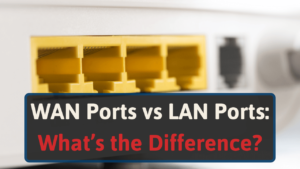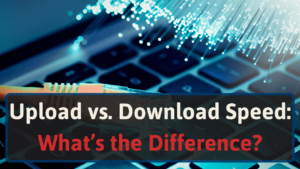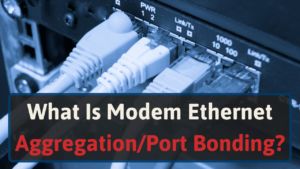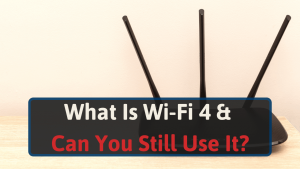Choose DSL internet over satellite internet in most scenarios. It’s cheaper, has better download speeds, and has less latency. However, it doesn’t have as much availability as its counterpart. Read on to learn more.
I want to find the best internet connection type for my home. That led me down a rabbit hole of comparing various options. This guide will cover digital service line (DSL) and satellite.
While reading, you’ll find the following:
- The winner
- Both connection types compared
- What cable internet is & popular providers
- What fixed wireless access is & popular providers
- Other internet options
Let’s do this!
Should You Get DSL or Satellite Internet?
Choose DSL internet over satellite internet in most scenarios. Here’s why:
- Lower latency
- Higher average download speeds
- More reliable due to a hardwired connection
- Much more affordable
You may have a better overall browsing experience with using Starlink satellite internet in some scenarios. For instance, DNS connections suffer from attenuation. Slower internet and higher latency the further you’re from your ISP.
If you’re far from your provider, Starlink will likely offer higher download speeds and lower ping. But you’ll need to fork over more money. And it’s difficult to know how far you live from your ISP.
DSL vs. Satellite Internet
Let’s compare cable and fiber optic internet:
| DSL | Satellite Internet | |
| Best For | Saving a bit of money & general browsing | Internet access in remote areas |
| Max. Speed | 120 Mbps | 100 Mbps |
| Avg. Latency | 34 ms | 469 ms |
| Avg. Monthly Fee | $51/mo. | $86/mo. |
| Equipment Needed | DSL modem & router | Flat panel antenna & satellite modem |
| Installation | Self-installation possible | Requires professional installation |
Are you wondering how I pulled up the average latency? No?
I’ll tell you anyway. I gathered the average latency for services each provider offered, then found the median numbers. The ping you’ll get will likely differ from what I listed.
DSL vs. Satellite: Latency
DSL has much lower latency than low-earth orbit and geostationary satellite internet providers. Less latency means you’ll have less lag during online video conferences and online gaming.
Low-earth orbit providers (e.g., Starlink) have much lower latency than geostationary companies like HughesNet. For instance, I’ve found some sources that suggest HughesNet has 400 ms ping. While Starlink has up to 50 ms.
The higher the ping, the more likely you’ll have lag. That’s not ideal during online calls because it could make it impossible to understand what the person on the other side of the call is saying. If you were to game online with 400 ms ping, your game will have so much lag that it’s unplayable.
I find games like MMOs and FPS unplayable at 200 ms ping.
Let’s keep moving.
DSL vs. Satellite: Speed
DSL usually offers higher download speeds than satellite internet. Except when compared to Starlink. Satellite internet connections don’t weaken when you’re further away from your ISP, but DSL does.
Satellite internet could have the upper hand in this category. Regardless. Both connection types could meet requirements for online tasks homes with at least 3 or fewer people. So long as they don’t frequently download files.
File downloads will burn through satellite providers’ data allowances. And it’ll demand a lot of downstream bandwidth from homes with DSL.
Upload speeds for both connection types aren’t the best. Perhaps you could run a single security camera with DSL internet without accounting for attenuation. I wouldn’t recommend the same with satellite internet.
Because you know—data limits.
I’d usually include a business section in these guides, but not in this scenario. I’ll knock it out here. The low download speeds make both connection types unviable for most business uses.
Unless you own a small shop that uses the internet for browsing and checking emails.
DSL vs. Satellite: Availability
Here’s an availability comparison between cable and fiber internet [1]:
- DSL:
- 0.2/0.2 Mbps: 57.71%
- 10/1.0 Mbps: 39.59%
- 25/3.0 Mbps: 22.82%
- 100/20 Mbps: 4.68%
- Satellite internet
- 25 Mbps: 99.96%
- 100–250 Mbps: 29.54%
Satellite internet offers much more support for high- and low-speed connectivity throughout the U.S. than DSL. And customers won’t have many high-speed internet options when it comes to DSL.
Meaning you’re stuck with satellite if you can’t access other internet connection types. I’ll talk about these later.
DSL vs. Satellite: Costs, Equipment, & Installation
DSL internet costs much less per year, doesn’t require data top-ups, and won’t require customers to pay equipment installation fees. However, they may have to pay for professional DSL installation.
Most customers could self-install DSL modems, though. That’s not the same with satellite providers. Because home receivers need the right positioning to interact with satellites in space, professionals must install them.
Which leads to professional installation costs.
Otherwise, you’ll need a DSL modem for service line internet. Satellite internet will require a satellite modem and a dish for homes.
DSL vs. Satellite: Reliability
DSL internet is more reliable than satellite. Since it relies on copper telephone cable, there’s no need to worry about bad weather conditions or trees interfering with your connection.
While uncommon, it’s also more likely for satellites to fall from the sky during solar events [2]. Meaning there are more variables for disruptions with your internet connection.
DSL vs. Satellite: For Gaming
Choose DSL internet over satellite for gaming in almost all circumstances.
Don’t use satellite internet for gaming. Unless it’s Starlink. HughesNet and Viasat have more than 400 ms of latency. Such high ping will lead to unbearable lag when you game online.
And their low data allowances wouldn’t give you much wiggle room for file downloads.
Packages all providers, satellite and DSL, offer speeds you’d need to game online casually. At least 3.0 Mbps (download). However, I wouldn’t use either for competitive gaming.
Fiber’s the only internet connection type I recommend for serious online gaming. But it doesn’t have much availability.
Anyway:
DSL doesn’t have data caps on any of their plans. For the most part. That removes worrying about game file downloads as a factor. And some plans provide enough upload speed to livestream on platforms like YouTube and Twitch.
DSL vs. Satellite: For Video Streaming
DSL internet is ideal for streaming content with 1080p or lower resolution on multiple devices. The low download speeds service loop internet provides makes it difficult to stream 4K without buffering. That doesn’t account for attenuation.
The further you live from your provider, the lower the internet speed you’ll get. In that case, your home could likely stream 720p HD or 480p SD video consistently.
But it’s better than satellite internet. Imagine having a HughesNet 15 GB plan and streaming 5 hours of 1080p FHD video. Then you’ll have to give them more money to add additional data.
Starlink does have the upper hand with its 1.0 terabyte (TB) data limit. It enables you to watch more than 169 hours of 4K UHD video [3]. Or more than 350 hours of 1080p FHD video.
Before proceeding, refer to this chart for reference:
| Task | Download Speed |
| Netflix | 3.0 Mbps: 720p 5.0 Mbps: 1080p 25 Mbps: 4K |
| Disney+ | 5.0 Mbps: 1080p 25 Mbps: 4K |
| Hulu | 3.0 Mbps: Hulu’s Streaming Library 8.0 Mbps: livestreaming television 16 Mbps: 4K |
| Peacock TV | 3.0 Mbps: 1080p |
| YouTube | 2.5 Mbps: 720p 5.0 Mbps: 1080p 20 Mbps: 4K |
If you find a DSL plan that provides 100 Mbps (consistent) download speeds, you’re a winner. Because you could watch 4K video on 4 devices simultaneously. Or 1080p on 20 devices.
What Is DSL Internet?
Digital service loop/line internet relies on copper telephone lines to deliver internet connectivity to customers’ DSL modems. DSL internet uses frequencies that landline phones don’t. That means you could use both services without interruptions.
Pros & Cons of DSL Internet
Here’s where DSL internet shines:
- More affordable: in some circumstances
- Dedicated circuit line: no sharing your connection with neighbors
- No phone service interference
- Doesn’t require installing new infrastructure
And here’s why DSL isn’t the best:
- Slower speeds when further from the provider
- Low upload speeds
Satellite internet has much more availability than DSL. If you choose a provider like Starlink, you’ll also have higher download (and maybe upload) speeds. All without having to deal with attenuation.
Attenuation refers to signal loss the further you live from your ISP. By signal loss, I mean higher latency and slower internet speeds.
Most Popular DSL Internet Providers
Check out the most popular DSL ISPs:
| Provider | * Starting Price | Max. Speed | # of States Serviced | Data Cap? |
| Frontier DSL | $28–$45/mo. | 6.0–45 Mbps | 25 (Availability Map) | No |
| AT&T DSL | $55–65/mo. | 0.8–500 Mbps (DL)0.4–100 Mbps (UL) | 21 (Availability Map) | 150 GB |
| CenturyLink | $50/mo. | 20–140 Mbps (DL)10–12 Mbps (UL) | 15 (Availability Map) | No |
| Kinetic by Windstream | $37/mo. | 100 Mbps | 18 | No |
* Does not include taxes and other fees. These will vary by region. Actual internet speed will vary by connectivity method (e.g., Wi-Fi vs. Ethernet) among other factors.
I only recommend CenturyLink and Windstream on this list. AT&T began phasing out its DSL services [4]. And my experience with Frontier’s customer service made it seem like they don’t focus much on their DSL service.
Because the customer service representative kept trying to convince me to get fiber. Though DSL was available. They’re also shy about showing their upload speeds, which makes it a bit difficult to compare.
Whether you choose each of the recommended ISPs depends on if they’re available in your area. Type your address on their availability map and see whether they support your area.
What Is Satellite Internet?
Internet providers deliver signals to customers’ homes through satellites orbiting around the Earth. However, the actual internet signal comes from network operations centers. These facilities will use satellites to redirect signals around the globe.
The satellites’ orbit will make an enormous difference in internet connectivity, though. And they are:
- Low-earth orbit (LEO):
- Higher speed & lower latency
- Better for gaming online & video calls
- Satellites float 300 miles away from Earth
- Starlink & Project Kuiper use these satellites
- Geostationary orbit:
- Low speed & high latency
- Use only for checking emails & online browsing
- Satellites hover 22,000 miles away from Earth
- HughesNet & Viasat use these satellites
Usually, satellite internet requires customers to get a home satellite dish and a satellite modem. HughesNet and Viasat don’t charge for this. However, Starlink charges $599.
Let’s check out the goods and bads of this connection type.
Pros & Cons of Satellite Internet
Wins I’ll give satellite internet include:
- Availability
Otherwise, satellite internet doesn’t do well in these areas:
- High latency: more than 200 ms on average
- Low soft data caps: 15–300 GB on average
- Expensive equipment fees: up to $500
- Pricey plans: costs $86 on average
DSL internet plans don’t include data caps or cost more than a AAA video game. They also have “OK” latency.
Most Popular Satellite Internet Providers
Let’s see what satellite internet providers you could choose from:
| Plan | * Starting Price | Max. Speeds (DL) | Installation Fee | Monthly Data |
| HughesNet | $64.99–$174.99/mo. | 25 Mbps | Free | 15–100 GB |
| Viasat | $69.99–$299.99/mo. | 30–150 Mbps | Free | 40–300 GB |
| Starlink | $110–$500/mo. | 50–500 Mbps | $599 | 1.0 TB |
* Does not include taxes and other fees. These will vary by region. Actual internet speed will vary by connectivity method (e.g., Wi-Fi vs. Ethernet), among other factors.
Starlink is the overall best option. They offer the most potential for download speeds, a much higher data limit, and lower latencies. Meaning, you could game online with satellite internet.
I can’t say the same for HughesNet and Viasat. Both providers have latency more than 400 ms (allegedly). This makes online gaming impossible. And don’t think about watching videos on these provider’s products.
Because streaming online videos will require a lot of data. Which will push you through the monthly data limit quicker. Use HughesNet and Viasat as backup internet. And when you do connect to the internet, use it for checking emails and browsing text- and image-based pages.
Other Internet Connection Types to Consider
Before considering a connection type, weigh in other options like the following:
| Internet Type | Strengths | Weaknesses | Best For |
| DSL | No data cap & reasonable DL speeds | Suffers from signal loss when you’re further from ISP | Watching 1080p videos |
| Satellite | More availability | Slow, high-latency, & expensive | Backup internet connection |
| Fiber | Equal DL/UL & no throttling | Availability | Any online task |
| Cable | More availability | Data caps, throttling, & low UL speeds | Watching videos (under 4K) & gaming online |
| Fixed Wireless | More availability & no data cap | Low UL speeds & physical obstacles could block your signal | Any online task that doesn’t require much upstream bandwidth |
Here are the connection types to choose in order:
- Fiber: highest speeds & lowest latencies
- 5G fixed wireless access: High speeds & no data cap
- Cable: low latency & high download speeds
- DSL: reliable and decent download speeds with homes having 2 or fewer people
- 4G fixed wireless access: similar speeds to DSL, yet more accessible
- Satellite: only viable as backup internet
Fiber dominates all other connection types with higher speeds, equal upload and download speeds (for the most part), and lower latency. If unavailable, 5G FWA could provide higher download speeds without data caps.
Fixed wireless doesn’t have the most reliability, though. If trees, buildings, or other obstacles reside between your home’s receiver and the ISP’s wireless tower, you’ll encounter signal disruptions.
In that case, you’ll want cable or DSL. Pick cable first, though. You’ll get faster internet and not have to worry about a weaker signal if you live further from your provider.
Satellite internet—pick it last.
FAQs: DSL & satellite Internet
Read on to find frequently asked questions about satellite and DSL internet.
Is DSL or satellite internet better for online gaming?
DSL internet is better for online gaming due to having lower latency.
Does satellite internet have data caps?
Satellite internet does not have hard data caps. Almost all satellite providers do enforce soft data caps, though. Meaning you’ll have throttled internet upon passing your allotted data.
Conclusion
DSL internet outperforms satellite in speed, reliability, and latency. But it doesn’t have much availability. Pick Starlink if you have extra money and don’t have access to other connection types.
It offers the highest speeds and lowest latency among its competitors.
If you have access to other connection types, explore reviews we wrote covering various providers. Find one who will provide the most value.






